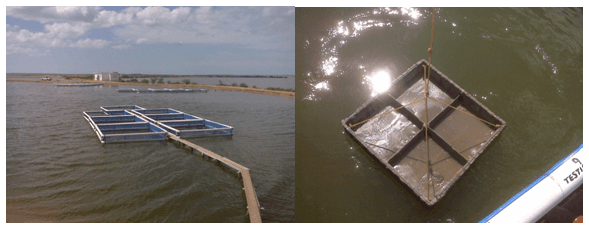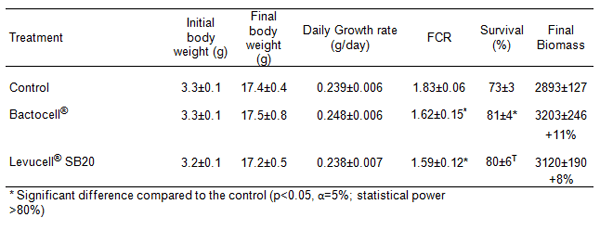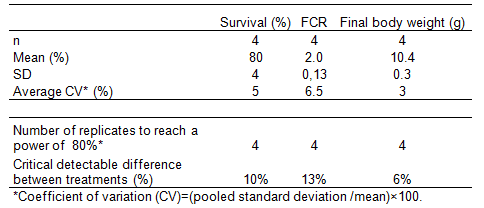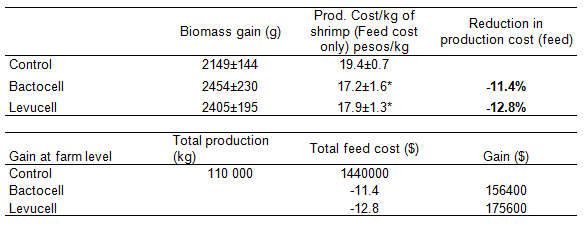Introduction
While commercial applications of probiotics are still at an early stage in Europe, it is yet a practical and commercial reality in many Aquaculture countries in Asia and South/central America. The use of probiotics in aquaculture has been originally developed with the aim to achieve a better management of disease and is now increasingly implemented on farms as part of farmer´s "Best Management Practices", particularly in semi extensive & intensive shrimp culture systems. Interestingly, beyond the management of disease, probiotics can also, through their holistic mode of action, contribute to optimize aquatic animal performance and would likely be helpful to address some of the challenges faced by the feed and aquaculture industry.
In the case of crustacean species, the development of the probiotic concept was first driven by practical and empirical approaches. Then over the last 10 to 15 years scientific studies and field reports on this topic have provided a foundation and showed the benefits that probiotics can achieve in shrimp farming, making this concept a now well accepted practice among the professionals of this sector.
However one can argue that most of the probiotic studies are conducted in small scale experiments units under laboratory conditions. For instance, our review of the literature highlights that more than 70% of the probiotic studies on shrimps were performed in laboratory, the rest being achieved in commercial hatcheries or under pond conditions. Therefore, even though some of the top priorities today are to better understand the mechanisms of action of probiotics in crustaceans and to improve the regulation around their use, it appears obvious that the efficiency of probiotics at a commercial scale requires "in situ" validation, ideally in ponds, to highlight the true value for the farmers.
However this is not an easy task and people having worked on the evaluation of feed additives in ponds at farm level know that such work is highly complex due to many logistical, economic and/or experimental constraints. The most obvious constraints were summarized in our previous study (Chim et al., 2008): (i) delivery of a high number of post-larvae (PL) coming from the same batch, which have to be seeded at the same time in all the ponds subject to experimentation, (ii) calculation of the final survival rate affected by possible under- or overestimation, particularly regarding the number of seeded PL and subsequently harvested animals, (iii) the supply of experimental feeds at an industrial scale and (iv) the high within-pond variability of the zootechnical responses, deriving inter alia from differences in pond characteristics, the origin and quality of post-larvae, and rearing management. To illustrate this last point it is indeed frequent for a semi-extensive farmer to observe large differences in the final survival rate between ponds of the same farm, while no specific treatments were applied. The within-farm variability between ponds make therefore difficult to use them as experimental units. As a result, many of the experiments on probiotics performed in shrimp culture ponds are inconclusive because of a weak statistical power below the commonly accepted threshold of 80% (Cohen, 1988). Statistical ´power´ signifies the capacity of an experiment to detect real differences, if they exist, at the desired significance level.
To compare treatments and to determine precisely whether a dietary probiotic has an effect or not, it is thus essential to standardize as much as possible these variables for every pond and ideally to realize an adequate number of replicates. Indeed a too small sample size will very often lead to difficulties of interpretation, misleading results and inevitably to rash conclusions. To overcome this problem we proposed and demonstrated that the use of floating cages in shrimp culture ponds is an economical, statistically powerful and sensitive experimental tool, particularly adapted to assess probiotics (Chim et al., 2008; Castex et al., 2008). Furthermore, trials in floating cages are certainly more representative of the pond conditions than laboratory trials in clear water and thus offer a good compromise. Such tool is today used by many feed companies to evaluate different raw materials or feed additives.
In the present study, Malta Cleyton and Lallemand Animal Nutrition evaluated the effect of two dietary probiotics, the bacteria strain Bactocell® (Pediococcus acidilactici MA18/5M) and yeast strain Levucell® SB (Saccharomyces cerevisiae boulardii CNCM I-1079), in Litopenaeus vannamei reared under commercial conditions in a farm from Northwest Mexico (Sinaloa) using a floating cages design. As we had previously shown the ability of these products to support the health of shrimps under challenging conditions (Castex, 2009), the main objective of this trial was to show whether we could detect the effect of the two probiotic formulations on performance of the white shrimp under semi-intensive farming conditions.
Materials and Methods
The study took place in a farm from Northwest Mexico (Sinaloa) using a floating cages design set up in one of the earthen pond of the farm (Picture 1). The trial was conducted under the supervision of Malta Cleyton technical staff. The floating cages system was previously validated on the farm for rearing of white shrimps from the post-larvae stage until harvest. Typically, the system was calibrated to growth L. vannamei from 3g to above 14g at a density of 25 animals/m2.
Figure 1. Left: Floating cages design and used during the experiment (farm from Northwest Mexico (Sinaloa)). Right: feeding tray/two feeding trays were set up per cage.

A total of four cages per treatment (3x4=12 cages, using 2 pontoons) were used in this experiment. Indeed, Chim et al. (2008) found under their conditions that for an expected difference of 20% from the control mean, 3 to 6 floating cages per treatment would be reasonable to determine statistical differences for growth parameters and survival rate respectively. In the present case, an a priori analysis ran on the data from previous experiments conducted in Mexico with the same floating cages design revealed a better sensitivity of the system. Indeed, based on the coefficients of variation measured between the cages, we found that four replicates per treatment would be adapted to detect a probiotic effect of minimum 10%, 13% and 6% respectively for the survival rate, the FCR and the Final body weight compared to the control with an error type I probability (α) of 5% and a statistical power of 80%.
Table 1. A priori analysis based on results from previous experiments using the same floating cages design
225 shrimps with an average initial body weight of 3.3 g±0.1 (SD) and originating from the same pond were then stocked in each cage (with a dimension of 3 x 3 meters) to reach a density of 25 pieces/m2 density. After the transfer, shrimp were acclimatized for two days and fed a standard commercial diet (Api-Camaron, Malta Cleyton) for two weeks (Table 2.). From day 3 onward, the shrimps were fed their respective diets for a period of 59 days up to an average final body weight of 17.4g±0.5 (SD). Three groups were considered: Control diet, Control diet + Bactocell® (5.106 CFU/g or 0.5g/kg of feed), Control diet + Levucell® SB (8.106 CFU/g or 400g/ton). For the treated groups, the probiotics (dried powder form) were top coated on the pellets and the feeds were then stored on site at room temperature until use.
Table 2. Proximal analysis of the commercial feed Api Camaron used during this trial (dry matter basis)
Shrimps were fed only on the feeding trays (2 trays per cages: 70 cm x 70 cm oyster banks) in order to be able to estimate consumption. Three meals per day were applied at 8:00 am, 1:00pm and 5:00pm. The feeding rate was adjusted every day for each cage according to the feed remaining on the trays after the meals. The food supply was calculated as a percentage of the biomass and average body weights per cage were estimated weekly (with a precision of 0.1g). The following parameters were therefore determined every week and at the end of the trial for the overall rearing period: weekly growth rate and average body weight, survival, biomass produced, and apparent feed conversion ratio (FCR=amount of given feed/shrimp wet biomass gain).
Results from the probiotic groups were compared to the control using non parametric test and Post hoc power analyses were used to assess a posteriori the statistical power based on a completely randomized design with two treatments using a one-tailed t-test of significance.
Additionally, the following physicochemical parameters of the water were determined daily (morning and evening) in order to evaluate the quality of the environmental conditions: Temperature, oxygen, salinity and turbidity. pH was also monitored two times per week.
Results & discussion
Rearing conditions over the course of the experiment were considered as optimal for L. vannamei. Indeed all the physicochemical parameters monitored over the period of the trial were considered as good. The temperature fluctuated with minimum values of 24.2°C in the morning and maximum values of 33.8°C in the afternoon. In the case of salinity, values were between the ranges of 34 to 39‰, while the turbidity fluctuated between 50 and 85 cm. The pH always remained constant ranking between 8 and 8.9, considered as acceptable values for L. vannamei. Oxygen values were also acceptable (2-5ppm on the morning and 8-10ppm in the afternoon), except for two days during the last week of the experiment were minimum values of 1.6 ppm were recorded in the morning. These low oxygen levels were also recorded at the same dates in other ponds of the farm and in any case never associated to sign of morbidity. Also it was considered not to have affected the outcome of the trial as it occured only two days before the harvest.
Under the conditions of this trial, overall growth performance during the trial were very good in all the groups with a final average body weight of 17.4g±0.5 (SD) for an average weekly growth rate of 0.24g/day. This result confirms previous trials conducted on the same farm and validates once more the floating cages system to assess different feeding regimes under commercial conditions.
Weekly sampling showed that shrimps exhibited very similar growth whatever the treatment, however at the end of the culture period the final average body weights of the shrimps were slightly higher in the Bactocell® group (Table 3). It is important to emphasize that under the conditions of this trial (type of feed used, optimal environmental conditions, adequate density, and absence of particular stress) the effect of the probiotic products on growth, if it exists, was too low to be detectable. From a practical point of view it is clear that under these conditions, the effect detected here can be considered as negligible.
Table 3. Zootechnical results in the control and the two probiotic groups

Survival rate in the control group was acceptable, reaching 73.8% at the end. Interestingly, the Bactocell® group had a much higher survival rate compared to the control (+10%, P<0.05; statistical power of 80%; Table 3) while the Levucell® SB group showed a similar trend even if the results were not significantly different from the control (p=0.11). This effect of Bactocell® on the survival rate of penaeid shrimps has been previously documented with several shrimp species (P. monodon, L. vannamei, L. stylirostris) under different conditions and was therefore expected. The mode of action of this probiotic in penaeid shrimp has even been documented and relies on a modulation of the gut microflora associated to a prevention of oxidative stress resulting in a better health status of the animals (Castex, 2009). The improvement in survival measured in the present trial resulted in an improvement of the final biomass by 11% and 8% compared to the control respectively for Bactocell® and Levucell® SB. Those results were associated to a significant improvement in the FCR in both probiotic groups compared to the control (p<0.05; statistical power >80%). This is often expected since by calculation a higher survival rate with similar growth performance results in a lower FCR. We also calculated the effect of the products on the relative production cost (feed cost) compared to the control group (Table 4). We confirm here that the benefits displayed by the two probiotics lead to a significant reduction in the feed cost at the farm level (-12% in average). This is a very important result especially if we consider that feed represent over 50% of the production cost and that reduction in production costs is one of the major issues today, right after disease, according a recent surveys on shrimp farming from the Global Outlook for Aquaculture Leadership (Valderrama & Anderson, 2011). If we consider the improvement at the farm level, based on the performance achieved by the farm in one cycle in 2011 (110 MT of shrimp produced), the use of the two probiotics would result in a reduction of the production cost of minimum 155000 pesos for the farmer for the same production volume.
Table 4. Biomass gain and Production cost (Feed cost) in the floating cages system for the three experimental groups
Finally, no statistical difference was recorded between the two probiotic groups for any of the parameters measured. It suggests that under such conditions, i.e. in the absence of any challenge, we were not able to detect a clear difference in the type of effect displayed by the probiotics, even though the mode of action of a live yeast and a live lactic acid bacteria are likely to be very different. It is interesting to notice however that in the case of LSB the improvement in FCR was more pronounced that with Bactocell®, suggesting a possible effect on feed utilization. This observation is being further investigated at the laboratory level since a previous experiment in clear water tanks have shown that Levucell® SB was able to significantly improve the feed conversion and the growth of penaeid shrimps (unpub. data).
Finally it is worth to add that as part of a second objective of the study (data no shown here), a fourth treatment was also considered to evaluate the effect of the yeast Levucell® SB when fed under an inactivated form (inactivation of the yeast by heat). Interestingly the results demonstrate that the live yeast Levucell® SB must be alive to display its effect
Conclusion
Overall the post Hoc power tests applied on the data confirmed that our experimental designed was well adapted to detect the probiotic effect on zootechnical performance. We confirmed here the capacity of Bactocell® to improve the survival rate of the shrimp under optimal rearing conditions in Mexico, resulting in economic benefits for the farmers. This result supports further the health promoting effect of Pedicococcus acidilactici MA18/5M in aquatic species and demonstrates that beyond conferring an "insurance" to the famers in case a challenging event would occur, Bactocell® can contribute to optimize the technical and economical performance under optimal rearing conditions.
The results regarding the live yeast Levucell® SB reveal an interesting effect on feed utilization even though we cannot conclude to its effect on survival as the sample size (n=4) used in this experiment did not allow to detect it. Further studies should address the mechanism of action involved and the effects of this live yeast on health and disease resistance of penaeid shrimps.
Nevertheless the two commercial products tested here have shown to be valuable tools to optimize performance and income over feed cost under Mexican shrimp farming conditions.
References
Castex, M., Chim, L., Pham, D., Lemaire, P., Wabete, N., Nicolas, J.-L., Schmidely, Ph. & Mariojouls, C. (2008) Probiotic P. acidilactici application in shrimp Litopenaeus stylirostris culture subject to vibriosis in New Caledonia. Aquaculture 275, 182-193
Chim, L., Castex, M., Pham, D., Brun, P., Lemaire, P., Wabete, N., Schmidely, P. & Mariojouls, C. (2009) Evaluation of floating cages as an experimental tool for marine shrimp culture studies under practical earthen pond conditions. Aquaculture 279, 63-69.
Cohen, J., 1988. Statistical Power Analysis for the Behavioral Sciences. 2nd ed. Lawrence Erlbaum associates, Inc., Hillsdale, NJ.
Valderrama, D. & Anderson, J.L. (2011). Shrimp production survey. GOAL 2011, Santiago, Chile.










.jpg&w=3840&q=75)